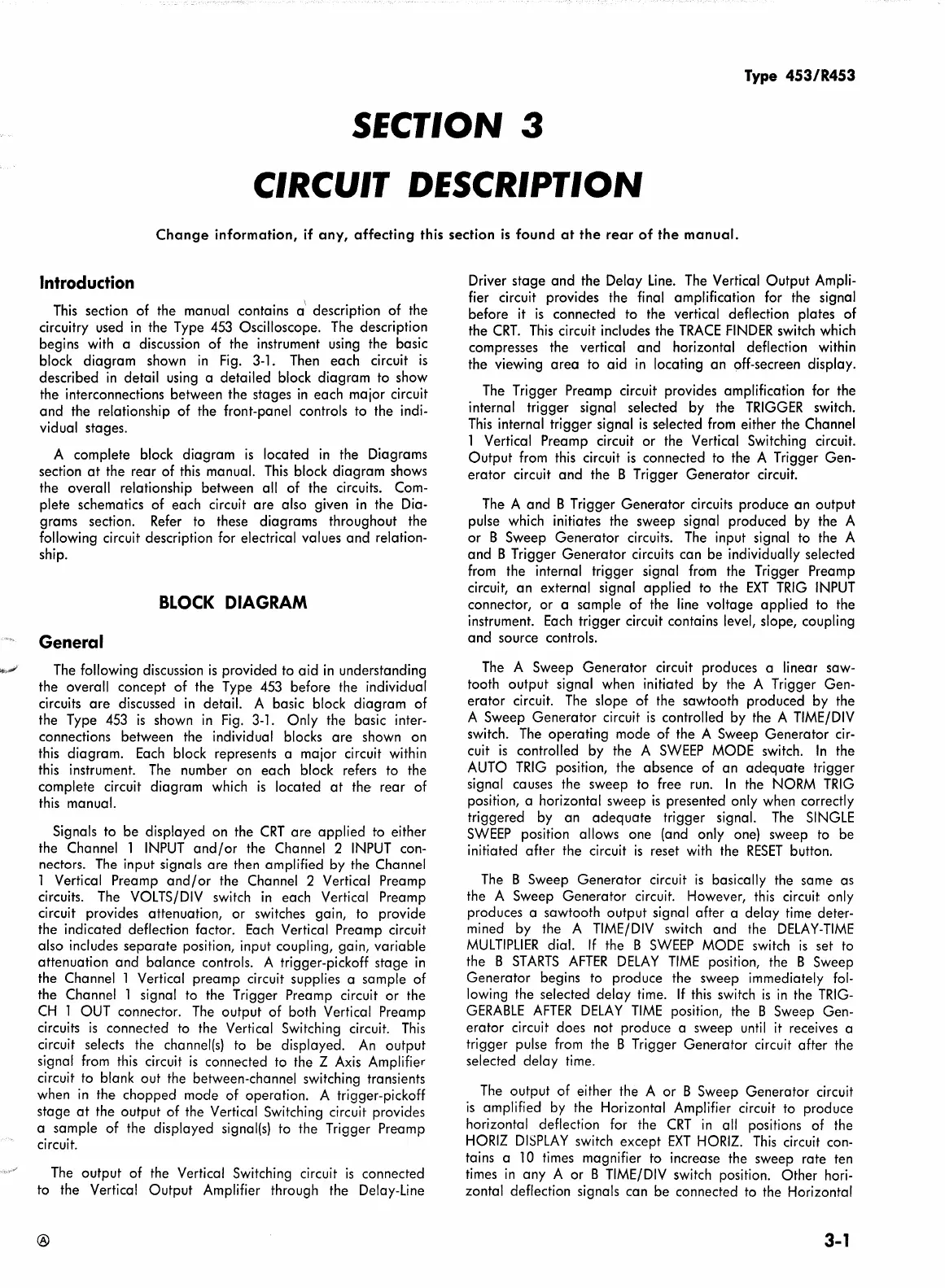Type
453/R453
SECTION 3
CIRCUIT
DESCRIPTION
Change
information,
if
any,
affecting
this section
is
found
at
the
rear
of
the
manual.
Introduction
This
section of the manual contains a
1
description of the
circuitry
used
in
the Type
453
Oscilloscope.
The
description
begins
with
a discussion of the instrument
using
the basic
block diagram shown
in
Fig.
3-1.
Then
each circuit
is
described
in
detail
using
a detailed block diagram
to
show
the interconnections between the stages
in
each major circuit
and the relationship of the front-panel controls
to
the
indi-
vidual stages.
A complete block diagram
is
located
in
the Diagrams
section
at
the rear of
this
manual.
This
block diagram shows
the overall relationship between all of the circuits.
Com-
plete schematics of each circuit are also given
in
the
Dia-
grams section.
Refer
to
these diagrams throughout the
following circuit description
for
electrical values and relation-
ship.
BLOCK
DIAGRAM
General
The
following discussion
is
provided
to
aid
in
understanding
the overall concept of the Type
453
before the individual
circuits
are
discussed
in
detail. A basic block diagram of
the Type
453
is
shown
in
Fig.
3-1.
Only the basic inter-
connections between the individual blocks are shown on
this
diagram.
Each
block represents a major circuit within
this
instrument.
The
number
on
each block refers
to
the
complete circuit diagram
which
is
located
at
the·
rear of
this
manual.
Signals to be displayed on the
CRT
are applied
to
either
the Channel
l
INPUT
and/or
the Channel 2
INPUT
con-
nectors.
The
input signals are then amplified
by
the Channel
l Vertical Preamp
and/or
the Channel 2 Vertical Preamp
circuits.
The
VOLTS/DIV
switch
in
each Vertical Preamp
circuit provides attenuation, or switches gain,
to
provide
the indicated deflection factor.
Each
Vertical Preamp circuit
also includes separate position, input coupling, gain, variable
attenuation and balance controls. A trigger-pickoff stage
in
the Channel 1 Vertical preamp circuit supplies a sample of
the Channel
l signal
to
the Trigger Preamp circuit or the
CH
l
OUT
connector.
The
output of both Vertical Preamp
circuits
is
connected
to
the Vertical Switching circuit.
This
circuit selects the channel(s)
to
be displayed.
An
output
signal
from
this
circuit
is
conneded
to
the Z
Axis
Amplifier
circuit
to
blank out the between-channel switching transients
when
in
the chopped mode of operation. A trigger-pickoff
stage
at
the output of the Vertical Switching circuit provides
a sample of the displayed signal(s)
to
the Trigger Preamp
circuit.
The
output of the Vertical Switching circuit
is
connected
to
the Vertical Output Amplifier through the Delay-Line
®
Driver stage and the Delay
Line.
The
Vertical Output
Ampli-
fier circuit provides the
final
amplification for the signal
before
it
is
connected
to
the vertical defledion plates of
the
CRT.
This
circuit includes the
TRACE
FINDER
switch
which
compresses the vertical and horizontal deflection within
the viewing
area
to
aid
in
locating an off-secreen display.
The
Trigger Preamp circuit provides amplification for the
internal trigger signal selected
by
the
TRIGGER
switch.
This
internal trigger signal
is
se·lected
from
either the Channel
1 Vertical Preamp circuit or the Vertical Switching circuit.
Output
from
this
circuit
is
connected
to
the A Trigger Gen-
erator circuit and the B Trigger Generator circuit.
The
A and B Trigger Generator circuits produce an output
pulse which initiates the sweep signal produced
by
the A
or B Sweep Generator circuits.
The
input signal
to
the A
and B Trigger Generator circuits can be individually selected
from
the internal trigger signal
from
the Trigger Preamp
circuit, an external signal applied
to
the
EXT
TRIG
INPUT
connector, or a sample of the
line
voltage applied
to
the
instrument.
Each
trigger circuit contains level, slope, coupling
and source controls.
The
A Sweep Generator circuit produces a linear saw-
tooth output signal when initiated
by
the A Trigger Gen-
erator circuit.
The
slope of the sawtooth produced by the
A Sweep Generator circuit
is
controlled
by
the A
TIME/DIV
switch.
The
operating mode of the A Sweep Generator
cir-
cuit
is
controlled
by
the A
SWEEP
MODE
switch.
In
the
AUTO
TRIG
position, the absence of an adequate trigger
signal causes the sweep
to
free
run.
In
the
NORM
TRIG
position, a horizontal sweep
is
presented only when correctly
triggered
by
an adequate trigger signal.
The
SINGLE
SWEEP
position allows one (and only
one)
sweep
to
be
initiated after the circuit
is
reset
with
the
RESET
button.
The
B Sweep Generator circuit
is
basically the same as
the A Sweep Generator circuit. However,
this
circuit only
produces a sawtooth output signal after a delay
time
deter-
mined
by
the A
TIME/DIV
switch and the
DELAY-TIME
MULTIPLIER
dial.
If
the B
SWEEP
MODE
switch
is
set
to
the B
ST
ARTS
AFTER
DELAY
TIME
position, the B Sweep
Generator begins
to
produce the sweep immediately
fol-
lowing the selected delay
time.
If
this
switch
is
in
the
TRIG-
GERABLE
AFTER
DELAY
TIME
position, the B Sweep Gen-
erator circuit does not produce a sweep
until
it
receives a
trigger pulse
from
the B Trigger Generator circuit after the
selected delay
time.
The
output of either the A or B Sweep Generator circuit
is
amplified
by
the Horizontal Amplifier circuit
to
produce
horizontal deflection
for
the
CRT
in
all positions of the
HORIZ
DISPLAY
switch except
EXT
HORIZ.
This
circuit
con-
tains a l 0
times
magnifier
to
increase the sweep rate
ten
times
in
any A or B
TIME/DIV
switch position. Other
hori-
zontal deflection signals can be connected
to
the Horizontal
3-1

